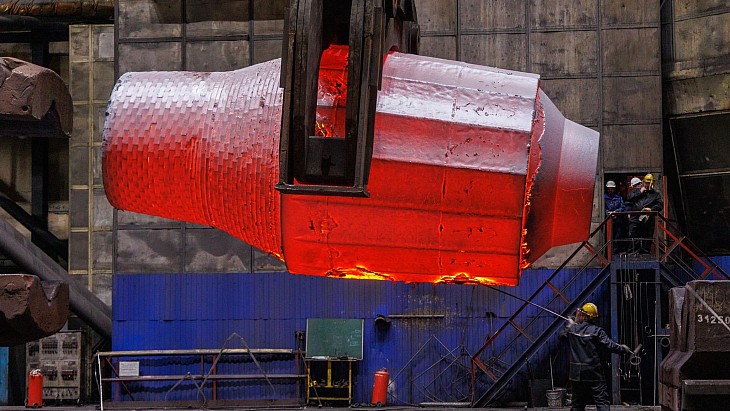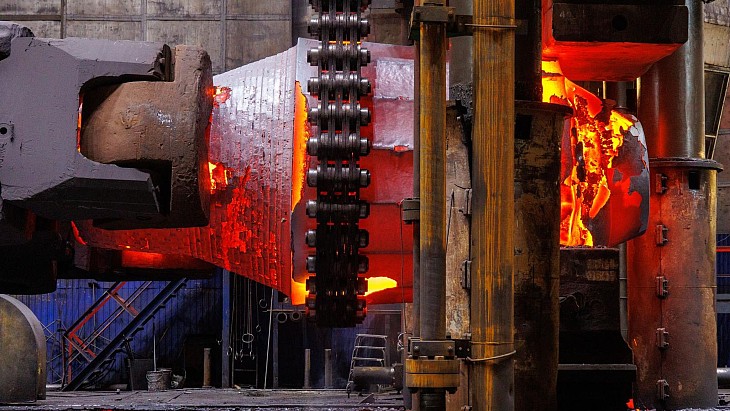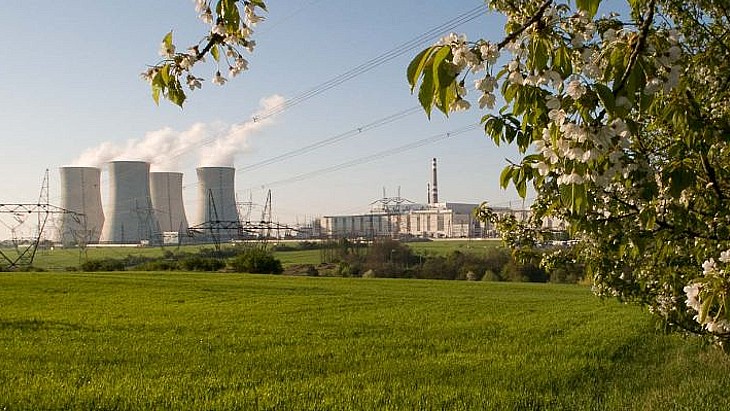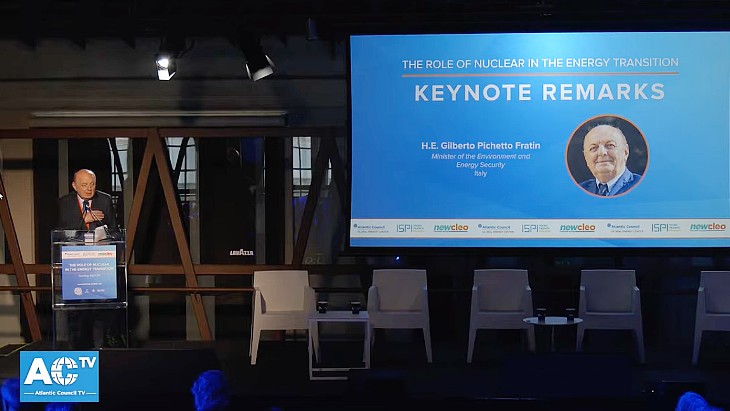Forging work begins for Paks II project reactor vessel
30 April 2024
The mayor of Paks in Hungary was among those present in Russia to see the start of forging of blanks for the reactor vessel of the first unit at the Paks II nuclear power plant, which Rosatom is building.
 The final reactor vessel could have a 100-year lifespan (Image: Strana Rosatom)
The final reactor vessel could have a 100-year lifespan (Image: Strana Rosatom)The mayor, Peter Szabo, and the CEO of Paks II, Gergely Jakli, saw the start of production at the AEM-Spetsstal plant in St Petersburg.
Jakli said: "We are working to ensure that the new power units of the Paks NPP can be connected to the grid by the early 2030s. Work for this is being carried out in parallel both at the construction site in Paks and several thousand kilometres from Hungary ... it is important for us that after the start of casting we can now see up close the initial stages of manufacturing the shells of the reactor vessel."
 (Image: Strana Rosatom)
(Image: Strana Rosatom)
Vitaly Polyanin, vice-president of Atomstroyexport JSC and director of the Paks II construction project, said that at the Paks II site work continues to strengthen the soil prior to the development of the pit. "By the end of 2024 we plan to reach first concrete ... in parallel with this, a lot of work is being done to manufacture the main equipment for the future nuclear power plant - a melt localisation device has already been produced, today the production of blanks for the reactor vessel of power unit 5 has begun, and ahead are blanks for steam generators, pressure compensators, safety system tanks and other products of the primary circuit of the nuclear power plant. nuclear power plant islands. The manufacture of equipment for the primary circuit of the nuclear island is planned in 2028 and 2029, and by then the main construction work will have already been completed."
The Paks II project was launched in early 2014 by an intergovernmental agreement between Hungary and Russia for two VVER-1200 reactors to be supplied by Rosatom, with the contract supported by a Russian state loan to finance the majority of the project. The construction licence application was submitted in July 2020 to construct Paks II alongside the existing Paks plant, 100 kilometres southwest of Budapest on the banks of the Danube river. The construction licence was issued in August 2022 and a construction timetable agreed last year which set out plans to connect the new units to the grid at the beginning of the 2030s.
The Paks II development company said the work was a key part of aiming for that 2030 target, adding: "The rings that make up the reactor vessel and the bottom of the vessel, are formed under about 12,000 tonnes of pressure during forging. The final mass of this piece of equipment is around 330 tonnes, its height is more than 11 metres, its diameter is 4.5 metres and its maximum wall thickness is 285 millimetres."
It added: "The VVER-1200 reactor vessel will not only be tested by the continuous neutron flux, but will also have to withstand temperatures of 300 degrees Celsius and pressures of 162 bar for a guaranteed 60 years. Thanks to its advanced composition and production technology, the reactor vessel might last up to 100 years."
The existing four units at Paks are VVER-440 reactors that started up between 1982 and 1987 and they produce about half of the country's electricity. Their design lifetime was for 30 years but that was extended in 2005 by 20 years to between 2032 and 2037. In December 2022, the Hungarian Parliament approved a proposal to further extend their lifespan, which means the plant could keep operating into the 2050s.
Thailand considers deployment of Seaborg power barge
30 April 2024
Thai innovative and sustainable power company Global Power Synergy Public Company Limited (GPSC) has signed a memorandum of understanding with Denmark's Seaborg Technologies ApS to explore the potential deployment of the compact molten salt reactor (CMSR) Power Barge in Thailand.
.jpg?ext=.jpg) The signing of the MoU between GPSC and Seaborg (Image: GPSC)
The signing of the MoU between GPSC and Seaborg (Image: GPSC)
The MoU was signed at Denmark's embassy in Bangkok on 24 April by GPSC President and CEO Worawat Pitayasiri and Seaborg CEO Klaus Nyengaard.
Under the MoU, GPSC - a subsidiary of Thai state-owned oil and gas company PTT Group - and Seaborg will assess how the CMSR Power Barge could be utilised in Thailand to support the country's transition to net-zero. They will use the assessment to scope an initial project where the commercial deployment of the CMSR Power Barge is feasible and commercially viable.
The study - expected to take about four years to complete - is intended to explore the use of the carbon-free electricity generated from Seaborg´s Power Barge to feed directly into the grid, as well as explore the potential use of the steam generated during operations.
Once the project has matured to investment-ready, both parties intend to attract foreign direct investments to realise the project. Based on the results of the studies, further collaboration, such as the development and deployment of a CMSR Power Barge with a capacity of between 200 MWe and 800 MWe, will be considered.
"GPSC is taking a leading role in exploring nuclear SMR technology in Thailand, and we are very excited to work with them," Nyengaard said. "Our expertise in nuclear will support GPSC development to strictly comply with the international requirements and both parties could exchange best practices for the joint feasibility. On top, we see new nuclear as a great addition to the Thai energy mix in transforming the future of energy in Thailand, setting a great example for newcomer countries to nuclear."
Seaborg's design is for modular CMSR power barges equipped with between two and eight 100 MWe CMSRs, with an operational life of 24 years. Instead of having solid fuel rods that need constant cooling, the CMSR's fuel is mixed in a liquid salt that acts as a coolant, which means that it will simply shut down and solidify in case of emergency. However, the low-enriched fluoride fuel salt is not yet commercially available, so Seaborg recently announced the initial power barges will be fuelled with low-enriched uranium (LEU).
In September last year, Indonesian power company Pertamina NRE signed an MoU with Seaborg to investigate the deployment of Seaborg's CMSR Power Barge in Indonesia.
The timeline for Seaborg, which was founded in 2014, is for commercial prototypes of its CMSR to be built in 2026 with commercial production of Power Barges beginning from 2028.
Fuel production agreement
On 6 March, Kepco Nuclear Fuel (KNF), GS Engineering & Construction and Seaborg signed an agreement for the feasibility study of CMSR nuclear fuel production development. This agreement follows the MoU for CMSR Nuclear Fuel Production between KNF, Seaborg and GS E&C, which was signed last June.
.jpg)
The signing of the fuel production agreement (Image: Seaborg)
The new agreement will facilitate a joint feasibility study, enabling all parties to determine the project's scope and timeline for establishing fuel salt production in accordance with their respective roles and collaborative endeavours.
"KNF possesses unique technology, enabling us to access future-growth technologies and pave the way for market expansion into Europe," said KNF President & CEO Choi Ik-Soo. "Moving forward, we are committed to advancing nuclear fuel technology through ongoing research and development, while expanding our presence in international markets. Our ultimate goal is to establish ourselves as a prominent global player in the nuclear fuel industry, fostering future growth and innovation."
KHNP and EDF submit updated bids for four new Czech units
30 April 2024
ČEZ and its Elektrárna Dukovany II subsidiary have received binding bids from Korea Hydro & Nuclear Power (KHNP) and France's EDF for the construction of four new nuclear units in the Czech Republic.
 Four VVER-440 units are currently in operation at the Dukovany site (Image: CEZ)
Four VVER-440 units are currently in operation at the Dukovany site (Image: CEZ)
The French and South Korean bidders, plus Westinghouse, had submitted binding bids in October for a fifth unit at the Dukovany nuclear power plant and non-binding offers for up to three more units - a sixth at Dukovany and two at the Temelin nuclear power plant. But in February the Czech government announced it was changing the tender to be binding offers for four new units, with Westinghouse not included because it "did not meet the necessary conditions".
Prime Minister Petr Fiala explained at the time that the decision to have binding offers for all four units was the result of the original tender suggesting that contracting for four units, rather than having separate processes, could have a 25% benefit in terms of costs.
Elektrárna Dukovany II (EDU II) will now assess the two offers - using a system based on International Atomic Energy Agency recommendations - from an economic, commercial and technical point of view and submit an evaluation report to the Czech government's trade and industry ministry. The aim is to finalise contracts ready for signing by 31 March 2025. The target date for start of trial operation of the first new unit is 2036, with commercial operation in 2038.
EDF is proposing its EPR1200 reactor, KHNP is proposing its APR1000 - both companies have stressed their agreements with Czech suppliers to localise work if selected.
EDF said its Updated Initial Bid Supplement "covers the supply of engineering, procurement, construction and commissioning activities ... the offer also covers the design and implementation activities for nuclear fuel and delivery of fuel assemblies for this programme".
Its proposal would also see Framatome, GE Steam Power and Bouygues Travaux Publics involved in the project which would have "a tailor-made Czech localisation process, enhancing economic value and skills development for the Czech Republic", with nearly 300 Czech companies identified already.
Luc Rémont, Chairman and CEO of EDF Group said: "By opting for a fleet approach with our European technology (EPR 1200), ČEZ and EDU II will secure a European partner committed to delivering the best technology with the best long-term benefits for the Czech industry and economy. The technological and industrial alignment between Paris and Prague that we propose holds the potential to reshape Europe’s new nuclear industry for generations to come."
KHNP CEO Jooho Whang delivered the company's binding offer, saying: "With successful projects in Korea and the United Arab Emirates, KHNP has proven that it builds on time, with quality and at the agreed price. We believe that KHNP is the best option for the Czech Republic in terms of timely completion of the first reactor by 2036 and energy security."
KHNP said the APR1000 reactor had already received European certification and said it had been designed "specifically for export to European countries and has been localised to meet European conditions and comply with requirements based on the latest International Atomic Energy Agency and Western European Nuclear Regulators Association standards".
It said that cooperation with Czech companies was a long-term priority, with more than 200 potential Czech suppliers identified and 50 memorandums of understanding signed, adding "KHNP is the only bidder counting on a Czech company for the delivery of the turbine, which is one of the most important and largest components in the nuclear power plant".
Also on Tuesday, the European Commission announced it had approved, under EU state-aid rules, the Czech government's support of the construction of the new nuclear. The Commission had opened its investigation in June 2022 and said that the proposals had been modified to take account of concerns during the process and the Commission "concluded that the aid is appropriate to achieve the objectives pursued, as well as proportionate as it is limited to the minimum necessary, while the competition distortions caused by the measure are minimised".
The Czech Republic currently gets about one-third of its electricity from the four VVER-440 units at Dukovany, which began operating between 1985 and 1987, and the two VVER-1000 units in operation at Temelín, which came into operation in 2000 and 2002. As well as the plans for the four new units, the country also has developing plans for small modular reactors.
Lufeng 5 inner dome hoisted into place
30 April 2024
The inner containment dome has been installed at unit 5 of the Lufeng nuclear power plant in China's Guangdong province. It is the first of two HPR1000 (Hualong One) under construction at the site, where four CAP1000s are also planned.
.jpg?ext=.jpg) The dome is hoisted into place (Image: CGN)
The dome is hoisted into place (Image: CGN)
The steel dome - measuring 45 metres in diameter and almost 14 metres in height, and weighing about 238 tonnes - was raised using 1600-tonne crawler crane and placed on top of the walls of the double containment structure. An outer dome will subsequently be installed over the inner one.
The dome is located on top of the nuclear island. Its main function is to ensure the integrity and leak tightness of the reactor building, and it plays a key role in the containment of radioactive substances.
The hoisting process for the inner dome, which began at 8.08am on 29 April, was completed in 1 hour and 8 minutes, China General Nuclear (CGN) announced.
.jpg)
The dome atop of the containment building (Image: CGN)
CGN said the milestone "marks the full transition of another Hualong One nuclear power unit from the civil construction stage to the equipment installation stage".
The construction of Hualong One reactors as units 5 and 6 at the Lufeng plant was approved by the State Council in April 2022.
First concrete for unit 5 was poured on 8 September 2022, with that for unit 6 following on 26 August last year. Units 5 and 6 are expected to be connected to the grid in 2028 and 2029, respectively.
The proposed construction of four 1250 MWe CAP1000 reactors (units 1-4) at the Lufeng site was approved by the National Development and Reform Commission in September 2014. However, their construction has yet to receive State Council approval. The CAP1000 design is the Chinese version of the Westinghouse AP1000.
According to CGN, once all six units are in operation, the Lufeng plant will generate about 52 TWh, which will reduce standard coal consumption by almost 16 million tonnes and reduce carbon dioxide emissions by more than 42 million tonnes.
Researched and written by World Nuclear News
.jpg?ext=.jpg) GEH Chief Procurement Officer Darion Jeralds, Jay Wileman, John MacQuarrie, and GEH Nuclear Supply Chain Leader Kimberly Perry mark the occasion as BWXT joins the qualified supplier group (Image: GE Vernova)
GEH Chief Procurement Officer Darion Jeralds, Jay Wileman, John MacQuarrie, and GEH Nuclear Supply Chain Leader Kimberly Perry mark the occasion as BWXT joins the qualified supplier group (Image: GE Vernova) The final reactor vessel could have a 100-year lifespan (Image: Strana Rosatom)
The final reactor vessel could have a 100-year lifespan (Image: Strana Rosatom) (Image: Strana Rosatom)
(Image: Strana Rosatom).jpg?ext=.jpg) The signing of the MoU between GPSC and Seaborg (Image: GPSC)
The signing of the MoU between GPSC and Seaborg (Image: GPSC).jpg)
 Four VVER-440 units are currently in operation at the Dukovany site (Image: CEZ)
Four VVER-440 units are currently in operation at the Dukovany site (Image: CEZ).jpg?ext=.jpg) The dome is hoisted into place (Image: CGN)
The dome is hoisted into place (Image: CGN).jpg)
 (Image: Screengrab from Atlantic Council TV/Youtube)
(Image: Screengrab from Atlantic Council TV/Youtube).jpg?ext=.jpg) The meeting of the G7 ministers (Image: G7 Italia)
The meeting of the G7 ministers (Image: G7 Italia) The industry statement is presented to Italy's Minister of the Environment and Energy Security, Gilberto Pichetto Fratin (Image: WNA)
The industry statement is presented to Italy's Minister of the Environment and Energy Security, Gilberto Pichetto Fratin (Image: WNA)
